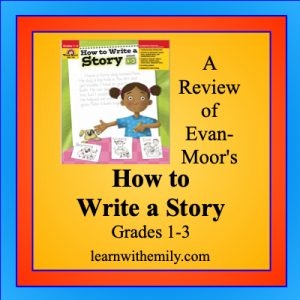This post may contain affiliate links. Affiliate links use cookies to track clicks and qualifying purchases for earnings. Please read my Disclosure Policy, Terms of Service, and Privacy policy for specific details.
My middle children love pretend play and coming up with imaginative story lines. Getting their thoughts down on paper is a little more difficult. Over the last couple of months, we have started using Evan-Moor’s book, How to Write a Story, Grades 1-3. I received a free copy in exchange for writing about our experiences.
Overview of How to Write a Story, Grades 1-3
When I first looked through How to Write a Story, I realized this book is actually a great writing guide with a lot of helpful sections. This book includes 4 step-by-step writing units, 4 types of story writing activities, and 9 writing center activities. The story writing process is differentiated into two levels. Level 1 is for beginning writers and level 2 is for more abled writers. This differentiation really helps beginners (level 1 children) understand that every story needs a beginning, middle, and end. The book guides you, the teacher/parent, through the process of teaching these components. Level 2 expands on these components and helps the teacher/parent guide children in recognizing the important parts of a story (e.g., characters, setting, action, and conclusion) through the use of story maps. Once you teach the important parts of a story, you are ready to move on to the writing units and activities.
4 Step-by-Step Writing Units
The Step-by-Step writing units provided differentiated instruction based on your child’s story writing skill level. For each writing unit, choose a group story, a guided practice story, or writing a story independently.
4 Types of Story Writing Activities
This section also includes detailed instructions and forms for writing stories. The four story type activities are retelling a fairy tale, a pattern story, a circle story, and a sequence story.
9 Story Writing Center Activities
This part of How to Write a Story provides everything you need to facilitate creative writing in a center format. It includes story prompts, questions, and graphic organizers to help motivate students in writing fun stories.
Benefits of How to Write a Story, Grades 1-3
Easy to adapt to different skill levels

I love that the step-by-step writing units are already differentiated for different skill levels. Since my children have special needs, this saves me so much time. If your child is typically developing and great at writing, if your child struggles with writing, or if you have an emerging writer, the work of adapting the lessons is already done for you. My children are not at the independent story writing level, but we were able to do group story and guided story lessons. I scribe for my children on the advanced organizers and in writing out their stories. One of my children loves drawing and drew fun illustrations to go with the stories she wrote. If you have a very reluctant writer, CLICK HERE to read about 4 adaptations that may help them respond better to writing assignments.
Really helps kids get important story components in their writing


I have used a variety of writing curricula with my children. My 1st and 3rd graders absolutely love writing stories and come up with some really fun and interesting ideas. One difference I noticed between Evan-Moor’s How to Write a Story and the other writing curriculum we’ve used is that the advanced organizers really helped focus the story on the important components (e.g., beginning, middle/problem, ending). Prior to using How to Write a Story, my children’s story ideas were all over the place. This may be fine for emerging writers (e.g., 4-5 year olds), but as children get older, fine tuning story ideas to include a problem the main character will face and how they will overcome that problem is an important next step.
Perfect supplement for 6-trait writing or any other writing curriculum
Evan-Moor’s Daily 6-Trait Writing provides lessons on ideas, organization, word choice, sentence fluency, and voice. These exact same skills are practiced in How to Write a Story, making it a perfect companion curriculum. CLICK HERE to read my review of Daily 6-Trait Writing. Practicing trait-based writing while writing a story is also a perfect supplement to any other writing curriculum you may be using.
Conclusion
My children have had a lot of fun with the writing activities in How to Write a Story. I would definitely recommend this product as a great supplement to any writing curriculum or on its own as a way to introduce and fine tune story writing skills at the elementary level. How to Write a Story is also available for grades 4-6. CLICK HERE to go to Evan-Moor’s website to see additional sample pages and to learn more.
How to Write a Story is included the the discounted Homeschool Bundles for grades 1, 3, and 5. CLICK HERE to see Evan-Moor’s Homeschool Bundle deals.
How to Write a Story is also included in a TeacherFileBox subscription. TeacherFileBox gives you access to educational content from over 450 Evan-Moor books. Use TeacherFileBox FREE for 30 days!


This book was key to getting my daughter excited to write stories as a third grader, and I completely agree that it really helps kids bring their stories together. My daughter was so proud of what she wrote from the lessons in this book.
It looks like your kids had a lot of fun writing some great stories! The illustrations are terrific, too. 🙂
Thanks so much for sharing!